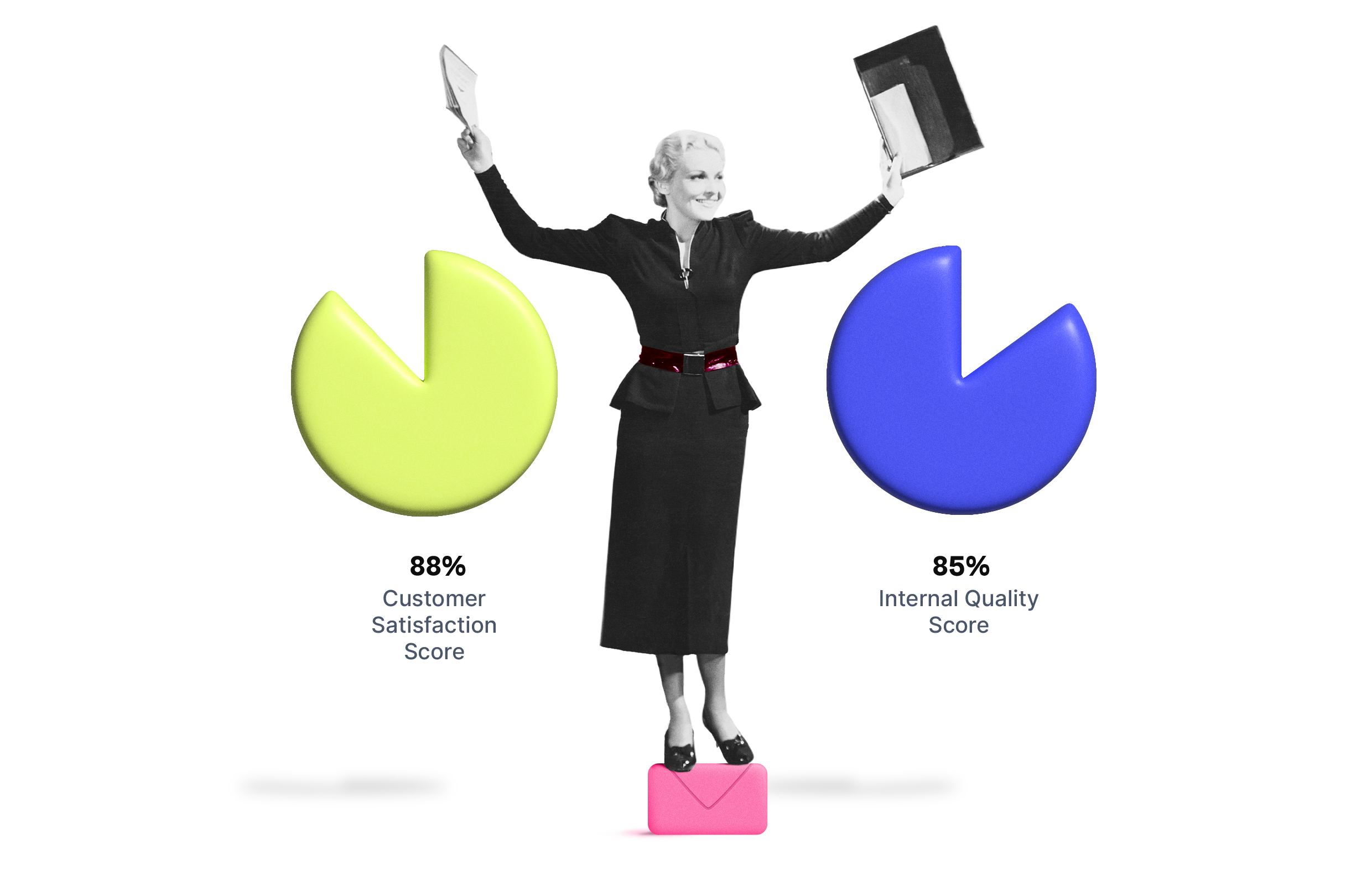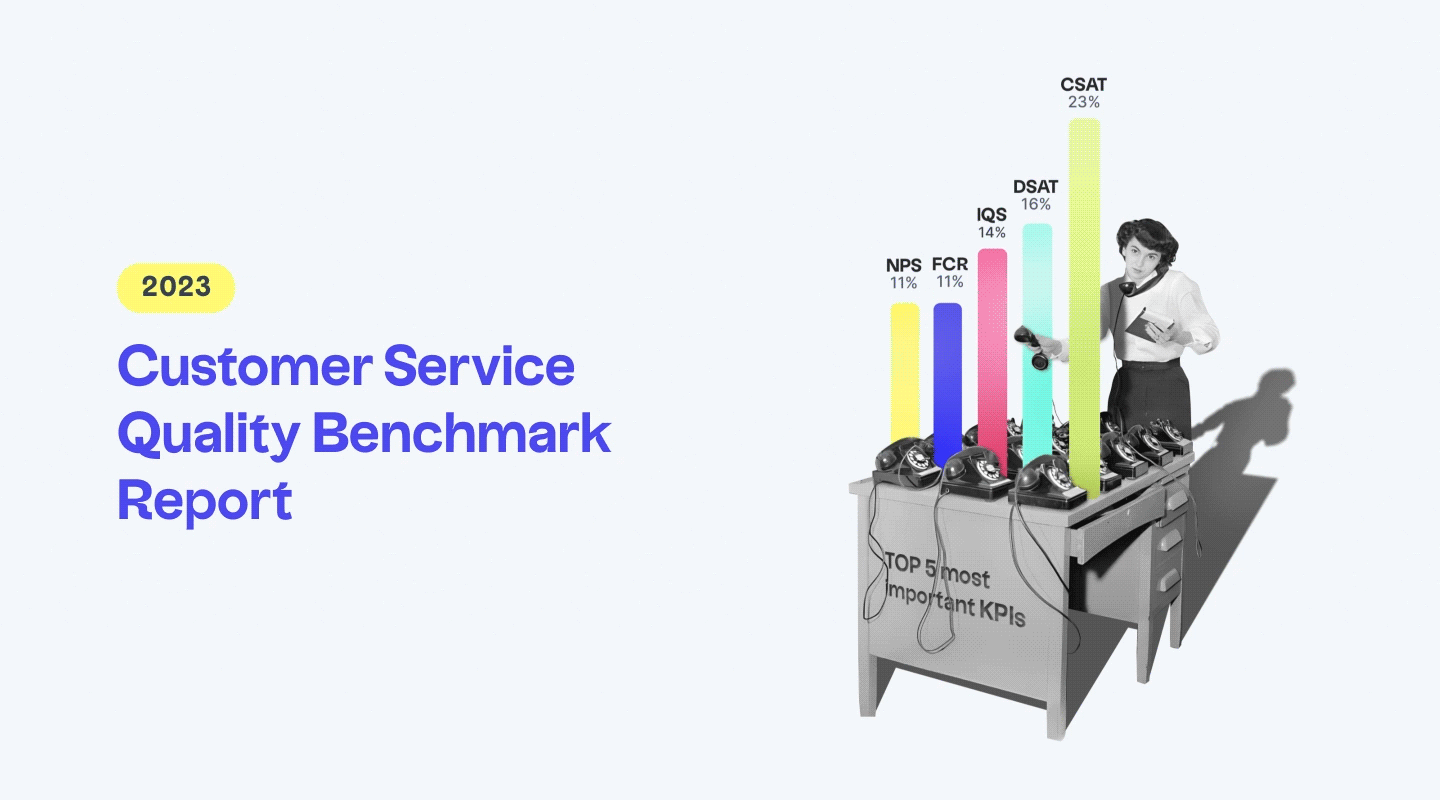Ever wondered how your customer service quality compares to your competitors and industry-wide standards?
Well, you’re about to find out. Here’s everything you need to know about customer service benchmarking, along with the most popular metrics to benchmark against.

What is customer service benchmarking?
Customer service benchmarking is the process of assessing your customer service performance and comparing it with the performance of other companies.
The way support professionals benchmark customer service varies from one team to another. Some may compare their performance against industry-wide metrics or standards, while others may choose to benchmark against a select group of top-performing competitors.
No matter which approach you go for, customer service benchmarking isn’t about copycatting their every move. It’s about gleaning insights from their best practices, finding areas where you could improve, and setting goals that would help elevate customer satisfaction.

Why is benchmarking important in customer service?
You could make some progress, but without a benchmark, your customer service department is likely to hit a plateau much sooner:
- Customer service benchmarks help you set an achievable standard for your support team based on what industry leaders are already accomplishing. They give you a realistic goal to aim for (and exceed).
- Benchmarking customer service provides you with a clear and defined path for improvement. By understanding where the industry standard is, you get a clear view of where your support quality currently stands and what you need to do to make it better.
- Benchmarking fosters a culture of continuous improvement in the organization, pushing everyone to consistently up their game. It’s not a one-time thing, but an ongoing process of comparing, learning, and improving.
If you’re serious about providing excellent service, check the numbers taken from the latest customer service benchmark report and compare them to yours.
What are some examples of customer service benchmarks?
- Customer Satisfaction Score (CSAT) benchmarks
- Internal Quality Score (IQS)
- First Contact Resolution (FCR)
- Net Promoter Score (NPS)
- Average Handle Time (AHT)
Now, let’s get to the heart of the matter — how to benchmark customer service. The numbers vary across different businesses, but here are a few common ones that most companies monitor:
Customer Satisfaction Score benchmarks
CSAT measures the satisfaction level of your customers with your services. A higher score usually indicates loyal and happy customers.
- According to the latest Customer Service Quality Benchmark Report, the CSAT benchmark for 2023 is 85%.
- CSAT is tracked by 38% of teams, while 23% of CS teams consider CSAT to be their most important KPI.
- CSAT is higher for chat and phone (86%) than for customer service emails (82%).
- The response rate for customer feedback surveys is also highest for chat (19%). Only 19% of CSAT ratings have a comment.
If you’d like to see how you compare against your industry standards, check out these CSAT benchmarks measured by ACSI:
- Online retailers — 80%
- Full-service restaurants — 80%
- Household appliances — 79%
- Personal computers — 79%
- Software — 78%
- Life insurance — 78%
- Banks — 78%
- Automobiles — 77%
- Shipping companies — 77%
- Online travel agencies — 76%
- Fast food restaurants — 76%
- Airlines — 76%
- Hotels — 75%
- Search engines and information — 75%
- Video streaming services — 74%
- Health insurance — 73%
- Social media — 71%
Internal Quality Score benchmark
IQS gives you a picture of your customer service quality based on internal quality standards that you set yourself.
- The IQS benchmark for 2023 is 88%.
- IQS is tracked by 36% of customer service teams.
- 14% of teams consider IQS to be their most important KPI.

First Contact Resolution benchmark
FCR reflects how often you’re able to resolve issues during the first interaction. It’s a great way to measure the efficiency of your customer service team.
- The FCR benchmark for 2023 is 70%
- FCR is tracked by 30% of CS teams.
- 11% of support teams consider FCR to be their most important KPI.
Net Promoter Score benchmark
NPS measures the likelihood of your customers recommending you to others. It’s a good indicator of how your customers perceive your company and the customer experience offered.
- The NPS benchmark for 2023 is +47.
- NPS is tracked by 28% of teams.
- 11% of support teams consider NPS to be their most important KPI.
- The average response rate to an NPS survey is 13%.

Average Handle Time benchmark
AHT is the average amount of time that a customer service representative spends handling a customer interaction. We all know time is of the essence in customer service, and this helps you keep an eye on yours.
According to the Customer Service Benchmark Report, the AHT benchmark for 2023 is:
- 12 minutes 39 seconds for customer service emails.
- 10 minutes for chats.
- 6 minutes 33 seconds for phone support.
- AHT is tracked by 25% of teams.

Source: Customer Service Quality Benchmark Report 2023
Which customer service metrics you should keep an eye on?
Benchmarking customer service metrics against industry-wide data should give you a clear picture of where you’re excelling and where there’s room for improvement. Even though the five metrics above are the most popular ones, it doesn’t necessarily mean that they’re the right benchmarks for your business.
Whether it’s Customer Effort Score (CES), First Response Time (FRT), or Customer Dissatisfaction Score (DSAT), you should benchmark customer service against the metrics that matter the most for your support team.
✨ For more industry standards, trends, and benchmarks, download the Customer Service Quality Benchmark Report →
Creating your own customer service benchmark report
And there you have it, that’s your starter pack on customer service benchmarking! Make sure to use industry standards as your North Star guiding you through the ever-changing terrain of customer expectations, and set goals for your support team accordingly.
When you benchmark customer service, though, remember that the numbers you track should be used for making things better, not for making yourself feline bad. While it’s tempting to keep up with industry leaders, it’s more important to see how you’re doing compared to how you were doing before. This shows where your company really stands, and how your customer service has grown over time.
At the end of the day, tracking relevant metrics is all about meeting business goals, improving support quality, and boosting customer loyalty & satisfaction.



